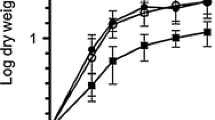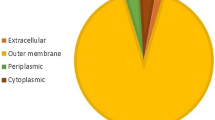Abstract
Objectives
The twin-arginine translocation (Tat) pathway is one of the bacterial secretory strategies which exports folded proteins across the cytoplasmic membrane.
Results
In the present study, we designed a novel Tat-signal peptide for secretion of human activin A used as a recombinant protein model here. In doing so, Haloferax volcanii, Halobacterium salinarum, and Escherichia coli Tat specific signal peptides were aligned by ClustalW program to determine conserved and more frequently used residues. After making the initial signal peptide sequence and doing some mutations, efficiency of this designed signal peptide was evaluated using a set of well-known software programs such as TatP, PRED-TAT, and Phobius. Then the best complex between TatC as an initiator protein in Tat secretory machine and the new designed signal peptide connected to activin A with the lowest binding energy was constructed by HADDOCK server, and ΔΔG value of − 5.5 kcal/mol was calculated by FoldX module. After that, efficiency of this novel signal peptide for secretion of human activin A to the periplasmic space of E. coli Rosetta-gami (DE3) strain was experimentally evaluated; to scrutinize the activity of the novel signal peptide, Iranian Bacillus Licheniformis α-Amylase enzyme signal peptide as a Sec pathway signal peptide was used as a positive control. The quantitative analysis of western blotting bands by ImageJ software confirmed the high secretion ability of the new designed signal peptide; translocation of 69% of the produced recombinant activin A to the periplasmic space of E. coli. Circular Dichroism (CD) spectroscopy technique also approved the proper secondary structure of activin A secreted to the periplasmic space. The biological activity of activin A was also confirmed by differentiation of K562 erythroleukemia cells to the red blood cell by measuring the amount of hemoglobin or Fe2+ ion using ICP method.
Conclusions
In conclusion, this novel designed signal peptide can be used to secrete any other recombinant proteins to the periplasmic space of E. coli efficiently.




Similar content being viewed by others
Abbreviations
- TM:
-
Transmembrane
- Tat:
-
Twin-arginine translocation
- SP:
-
Signal peptide
- aa:
-
Amino acid
- SDS–PAGE:
-
Sodium dodecyl sulfate–polyacrylamide gel electrophoresis
References
Anné J, Maldonado B, Van Impe J, Van Mellaert L, Bernaerts K (2012) Recombinant protein production and streptomycetes. J Biotechnol 158:159–167. https://doi.org/10.1016/j.jbiotec.2011.06.028
Bagos PG, Nikolaou EP, Liakopoulos TD, Konstantinos D (2010) Combined prediction of Tat and Sec signal peptides with Hidden Markov models. Bioinformatics 26:2811–2817. https://doi.org/10.1093/bioinformatics/btq530
Bendtsen JD, Nielsen H, Widdick D, Palmer T, Brunak S (2005) Prediction of twin-arginine signal peptides. BMC Bioinform 6:167. https://doi.org/10.1186/1471-2105-6-167
Berks BC, Sargent F, Palmer T (2000) The Tat protein export pathway. Mol Microbiol 35:260–274. https://doi.org/10.1046/j.1365-2958.2000.01719.x
Bilezikjian LM, Blount AL, Corrigan AZ, Leal A, Chen Y, Vale WW (2001) Actions of activins, inhibins and follistatins : implications in anterior pituitary function. Clin Exp Pharmacol Physiol 28:244–248. https://doi.org/10.1046/j.1440-1681.2001.03422.x
Brüser T (2007) The twin-arginine translocation system and its capability for protein secretion in biotechnological protein production. Appl Microbiol Biotechnol 76:35–45. https://doi.org/10.1007/s00253-007-0991-z
Caspers M, Brockmeier U, Degering C, Eggert T, Freudl R (2010) Improvement of Sec-dependent secretion of a heterologous model protein in Bacillus subtilis by saturation mutagenesis of the N-domain of the AmyE signal peptide. Appl Microbiol Biotechnol 86:1877–1885. https://doi.org/10.1007/s00253-009-2405-x
Chojnacki S, Cowley A, Lee J, Foix A, Lopez R (2017) Programmatic access to bioinformatics tools from EMBL-EBI update : 2017. Nucleic Acids Res 45:550–553. https://doi.org/10.1093/nar/gkx273
de Leeuw E, Granjon T, Porcelli I, Alami M, Carr SB, Müller M, Berks BC (2002) Oligomeric properties and signal peptide binding by Escherichia coli Tat protein transport complexes. J Mol Biol 322:1135–1146. https://doi.org/10.1016/S0022-2836(02)00820-3
De Maio A (1994) Protein blotting and immunoblotting using nitrocellulose membranes. In: Dunbar B (ed) Protein blotting: a practical approach. Oxford University Press, New York, pp 11–32
Deli A, Kreidl E, Santifaller S, Trotter B, Seir K, Berger W, Grusch M (2008) Activins and activin antagonists in hepatocellular carcinoma. World J Gastroenterol 14:1699–1709. https://doi.org/10.3748/wjg.14.1699
Dilks K, Rose RW, Hartmann E, Pohlschröder M (2003) Prokaryotic utilization of the twin-arginine translocation pathway: a genomic survey. J Bacteriol 185:1478–1483. https://doi.org/10.1128/JB.185.4.1478-1483.2003
Fang L, Wang YN, Cui XL, Fang SY, Ge JY, Sun Y, Liu ZH (2012) The role and mechanism of action of activin A in neurite outgrowth of chicken embryonic dorsal root ganglia. J Cell Sci 125:1500–1507. https://doi.org/10.1242/jcs.094151
Fathi-Roudsari M, Akhavian-Tehrani A, Maghsoudi N (2016) Comparison of three Escherichia coli strains in recombinant production of reteplase. Avicenna J Med Biotechnol 8:16–22
Gholami Tilko P, Hajihassan Z, Moghimi H (2017) Optimization of recombinant β-NGF expression in Escherichia coli using response surface methodology. Prep Biochem Biotechnol 47:406–413. https://doi.org/10.1080/10826068.2016.1252927
Gohlke U, Pullan L, McDevitt CA, Porcelli I, de Leeuw E, Palmer T, Berks BC (2005) The TatA component of the twin-arginine protein transport system forms channel complexes of variable diameter. Proc Natl Acad Sci USA 102:10482–10486. https://doi.org/10.1073/pnas.0503558102
Hajihassan Z, Abdi M, Yasaghi ER, Rabbani-Chadegani A (2017) Optimization of recombinant ß-NGF purification using immobilized metal affinity chromatography. Minerva Biotecnol 29:126–132. https://doi.org/10.23736/S1120-4826.17.02225-X
Hall TA (1999) BioEdit: a user-friendly biological sequence alignment editor and analysis program for windows 95/98/NT. Nucl Acids Symp Ser 41:95–98
Jeong KJ, Lee SY (2001) Secretory production of human granulocyte colony-stimulating factor in Escherichia coli. Protein Expr Purif 23:311–318. https://doi.org/10.1006/prep.2001.1508
Jones KL, Kretser DMD, de Patella S, Phillips DJ (2004) Activin A and follistatin in systemic inflammation. Mol Cell Endocrinol 225:119–125. https://doi.org/10.1016/j.mce.2004.07.010
Joseph Sambrook DWR (2001) Molecular cloning: a laboratory manual, 3rd edn. Coldspring-Harbour Laboratory Press, Plymouth
Käll L, Krogh A, Sonnhammer ELL (2004) A combined transmembrane topology and signal peptide prediction method. J Mol Biol 338:1027–1036. https://doi.org/10.1016/j.jmb.2004.03.016
Laemmli UK (1970) Cleavage of structural proteins during the assembly of the head of bacteriophage T4. Nature 227:680–685. https://doi.org/10.1038/227680a0
Libby RT, Braedt G, Kronheim SR, March CJ, Urdal DL, Chiaverotti TA, Cosman D (1987) Expression and purification of native human granulocyte-macrophage colony-stimulating factor from an Escherichia coli secretion vector. DNA 6:221–229. https://doi.org/10.1089/dna.1987.6.221
Makrides SC (1996) Strategies for achieving high-level expression of genes in Escherichia coli. Microbiol Rev 60:512–538
Munz B, Smola H, Engelhardt F, Bleuel K, Brauchle M, Lein I, Werner S (1999) Overexpression of activin A in the skin of transgenic mice reveals new activities of activin in epidermal morphogenesis, dermal fibrosis and wound repair. EMBO J 18:5205–5215. https://doi.org/10.1093/emboj/18.19.5205
Palmer T, Berks BC (2012) The twin-arginine translocation (Tat) protein export pathway. Nat Rev Microbiol 10:483–496. https://doi.org/10.1038/nrmicro2814
Philip LA, Tullman-Ercek GG (2006) The bacterial twin-arginine translocation pathway. Annu Rev Microbiol 60:373–395. https://doi.org/10.1146/annurev.micro.60.080805.142212
Ramasamy S, Abrol R, Suloway CJM, Clemons WM (2013) The glove-like structure of the conserved membrane protein TatC provides insight into signal sequence recognition in twin-arginine translocation. Structure 21:777–788. https://doi.org/10.1016/j.str.2013.03.004
Ren GH, Cao LC, Kong W, Wang ZJ, Liu YH (2016) Efficient secretion of the β-Galactosidase Bgal1-3 via both Tat-dependent and Tat-independent pathways in Bacillus subtilis. J Agric Food Chem 64:5708–5716. https://doi.org/10.1021/acs.jafc.6b01735
Rosano GL, Ceccarelli EA (2014) Recombinant protein expression in Escherichia coli: advances and challenges. Front Microbiol 5:1–17. https://doi.org/10.3389/fmicb.2014.00172
Rose RW, Brüser T, Kissinger JC, Pohlschröder M (2002) Adaptation of protein secretion to extremely high-salt conditions by extensive use of the twin-arginine translocation pathway. Mol Microbiol 45:943–950. https://doi.org/10.1046/j.1365-2958.2002.03090.x
Samant S, Gupta G, Karthikeyan S, Haq SF, Nair A, Sambasivam G, Sukumaran S (2014) Effect of codon-optimized E. coli signal peptides on recombinant Bacillus stearothermophilus maltogenic amylase periplasmic localization, yield and activity. J Ind Microbiol Biotechnol 41:1435–1442. https://doi.org/10.1007/s10295-014-1482-8
Sargent F, Stanley NR, Berks BC, Palmer T (1999) Sec-independent protein translocation in Escherichia coli. A distinct and pivotal role for the TatB protein. J Biol Chem 274:36073–36082. https://doi.org/10.1074/jbc.274.51.36073
Sargent F, Berks BC, Palmer T (2002) Assembly of membrane-bound respiratory complexes by the Tat protein-transport system. Arch Microbiol 178:77–84. https://doi.org/10.1007/s00203-002-0434-2
Schneider CA, Rasband WS, Eliceiri KW (2012) NIH Image to ImageJ: 25 years of image analysis. Nat Methods 9:671–675. https://doi.org/10.1038/nmeth.2089
Schwall RH, Lai C (1991) Erythroid differentiation bioassays for activin. Methods Enzymol 198:340–346. https://doi.org/10.1016/0076-6879(91)98035-5
Schymkowitz J, Borg J, Stricher F, Nys R, Rousseau F, Serrano L (2005) The FoldX web server: an online force field. Nucleic Acids Res 33:382–388. https://doi.org/10.1093/nar/gki387
Thomas JD, Daniel RA, Errington J, Robinson C (2001) Export of active green fluorescent protein to the periplasm by the twin-arginine translocase (Tat) pathway in Escherichia coli. Mol Microbiol 39:47–53. https://doi.org/10.1046/j.1365-2958.2001.02253.x
Thompson TB, Woodruff TK, Jardetzky TS (2003) Structures of an ActRIIB:activin a complex reveal a novel binding mode for TGF-β ligand:receptor interactions. EMBO J 22:1555–1566. https://doi.org/10.1093/emboj/cdg156
Van Zundert GCP, Van RJPGLM, Trellet M, Schmitz C (2016) The HADDOCK2.2 web server : user-friendly integrative modeling of biomolecular complexes. J Mol Biol 428:720–725. https://doi.org/10.1016/j.jmb.2015.09.014
Yamabhai M, Emrat S, Sukasem S, Pesatcha P, Jaruseranee N, Buranabanyat B (2008) Secretion of recombinant Bacillus hydrolytic enzymes using Escherichia coli expression systems. J Biotechnol 133:50–57. https://doi.org/10.1016/j.jbiotec.2007.09.005
Yang C, Freudl R, Qiao C (2009) Export of methyl parathion hydrolase to the periplasm by the twin-arginine translocation pathway in escherichia coli. J Agric Food Chem 57:8901–8905. https://doi.org/10.1021/jf901739g
Zimmermann L, Stephens A, Nam S, Rau D, Kübler J, Lozajic M, Alva V (2018) A completely reimplemented MPI bioinformatics toolkit with a new HHpred server at its core. J Mol Biol 430:2237–2243. https://doi.org/10.1016/j.jmb.2017.12.007
Zoufaly S, Fröbel J, Rose P, Flecken T, Maurer C, Moser M, Müller M (2012) Mapping precursor-binding site on TatC subunit of twin arginine-specific protein translocase by site-specific photo cross-linking. J Biol Chem 287:13430–13441. https://doi.org/10.1074/jbc.M112.343798
Acknowledgements
The authors would like to acknowledge the financial support of University of Tehran for this research under Grant Number 28669/06/09. This work was supported also by grant from Iran National Science Foundation with Grant Number 91000470.
Author information
Authors and Affiliations
Corresponding author
Additional information
Publisher's Note
Springer Nature remains neutral with regard to jurisdictional claims in published maps and institutional affiliations.
Rights and permissions
About this article
Cite this article
Zandsalimi, F., Hajihassan, Z. & Hamidi, R. Denovo designing: a novel signal peptide for tat translocation pathway to transport activin A to the periplasmic space of E. coli. Biotechnol Lett 42, 45–55 (2020). https://doi.org/10.1007/s10529-019-02752-9
Received:
Accepted:
Published:
Issue Date:
DOI: https://doi.org/10.1007/s10529-019-02752-9




